Call it the 1984 Nickel or the 1984 Jefferson Nickel, but don’t ever call it worthless. It may have a face value of five cents, but the 1984 Nickel has made some meaningful gains over the almost four decades it’s been in circulation.
Circulated 1984 Nickels may struggle to reach the 20-cent valuation, but in a mint state, these nickels can be worth $500 in the right condition. This is the 1984 Nickel value guide, where we discuss what this Jefferson Nickel is worth. We’ll also touch upon all the varieties of the 1984 Nickel and how much value they hold.
But first, a highlight of the value of the 1984 nickel in various conditions.
1984 Nickel Valuation Chart
| 1984 Nickel Condition | Mint Variety | ||
| 1984-P Nickel | 1984-D Nickel | 1984-S Proof Nickel | |
| Good (G4) | $0.10 | $0.10 | – |
| Fine (F12) | $0.10 | $0.10 | – |
| Extremely Fine (XF40) | $0.10 | $0.10 | – |
| Uncirculated (MS60) | $0.25 | $0.25 | $0.30 |
| Brilliant Uncirculated (MS65) | $10 | $7.50 | $1.75 |
| Brilliant Uncirculated (MS67) | $75 | $70 | $5 |
| Brilliant Uncirculated (MS69) | – | – | $12.50 |
1984 Nickel: Historical Background
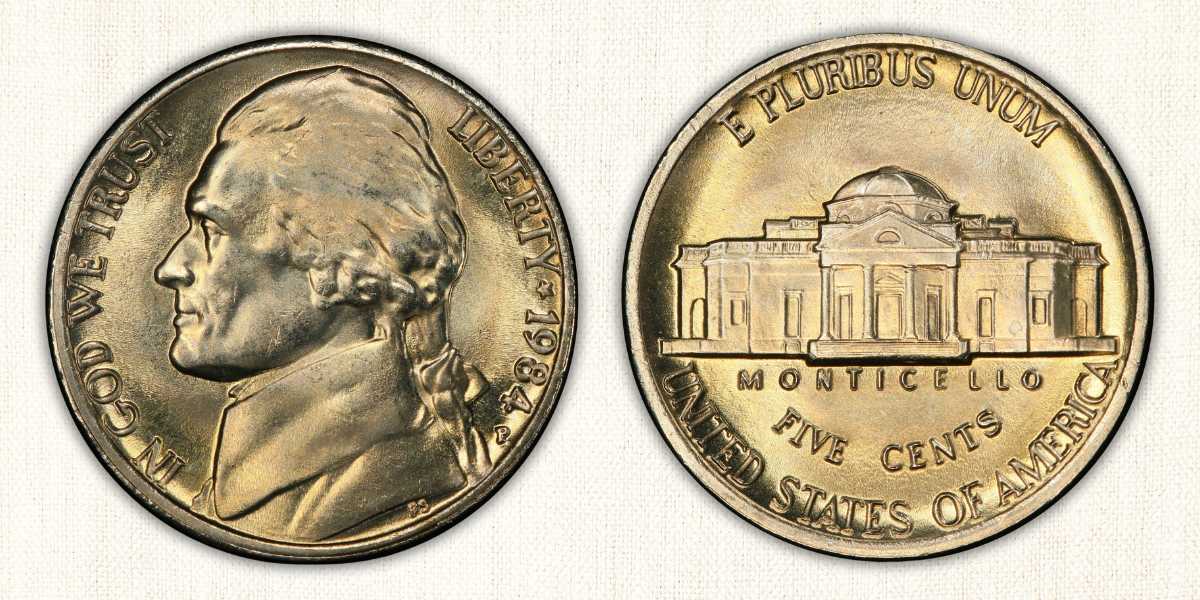
The 1984 Nickel is the 47th iteration of the Jefferson Nickel, so it shares in the rich history of the Jefferson Nickel. The first release of the Jefferson Nickel was in 1938, and it was a numismatic tribute to the third president and author of the Declaration of Independence, Thomas Jefferson. The obverse bore the image of Thomas Jefferson, while the reverse depicted his residence, Monticello.
Since 1938, the Jefferson Nickel has faced some production challenges, including the die’s susceptibility to wear, especially among the steps of Monticello, President Jefferson’s home. Even as early as 1939, the U.S. Mint recut the dies to sharpen these steps.
Unfortunately, this action was just a temporary fix, as some coins were struck with fuzzy steps while others had full steps. This challenge in the minting process was so common that the unofficial way to judge whether a Jefferson Nickel was well-struck was the presence (or lack thereof) of full steps on Monticello. This trend led to the rise of the “Full Steps” variety of the Jefferson Nickel.

In 1982, the U.S. Mint recut the dies one more time to sharpen the steps of Monticello, drastically increasing the chances of getting well-struck 1984 Jefferson Nickels.
1984 Nickel: Physical Features
The Jefferson Nickel has always had a silver coloration, through wartime and in peace. The 1984 Nickel continued in that tradition. To achieve this color, the U.S. Mint made the 1984 Nickels from copper and nickel.
To make these copper-nickel planchets, the U.S. Mint combined the two metals using a heat treatment called Annealing. Everything about this treatment is cool except for one issue: combining these metals in a ratio of 3:1 leads to a peculiar behavior among the metals. In improperly annealed planchets, the metals separate from each other and move to areas of relative purity.
Some 1984 Nickels will appear as though they are peeling. They may even take on the bronze-like color of copper. This phenomenon led to a new error coin: the Improperly Annealed Planchet.
But to refocus on the physical features of the 1984 planchet, below is a table highlighting these characteristics.
1984 Nickel: Physical Characteristics
| Physical Feature | Notes |
| Color | Silver |
| Metallic Composition | 75% Copper
25% Nickel |
| Weight | 5 grams |
| Diameter | 21.21 mm |
| Edge | Plain |
Obverse Design and Features
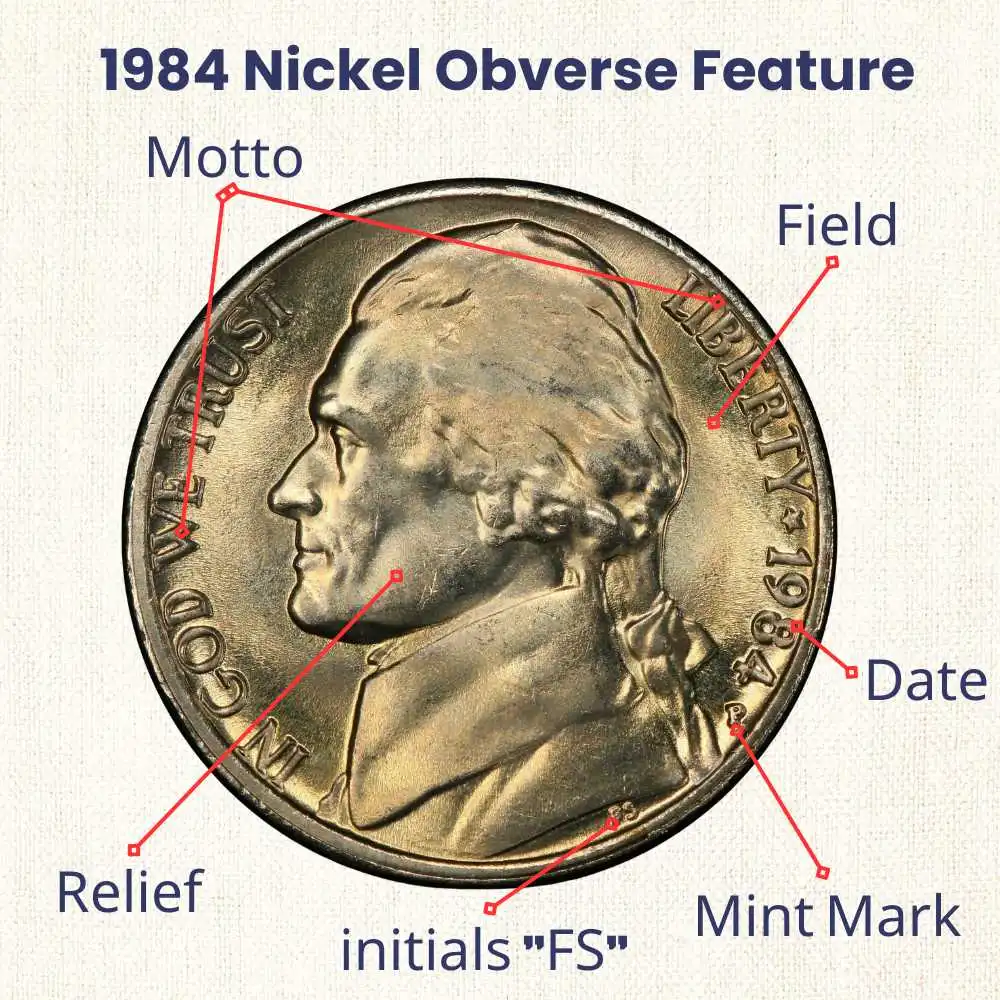
The 1984 Nickel bears the obverse design similar to the one that graced the first Jefferson Nickel in 1938. It has the same design that was drawn by Felix Schlag, albeit with the addition of Schlag’s initials (FS). These initials weren’t present on the Jefferson Nickel until 1966. At that time, the U.S. Mint decided to honor Schlag’s contribution to the original Jefferson Nickel.
The following elements are included on the obverse of the 1984 Nickel:
- The left-facing profile of Thomas Jefferson
- The motto “IN GOD WE TRUST“
- The legend “LIBERTY“
- A solitary star
- The year “1984“
- The mint mark (P, D, or S)
- Felix Schlag’s initials (FS)
Reverse Design and Features
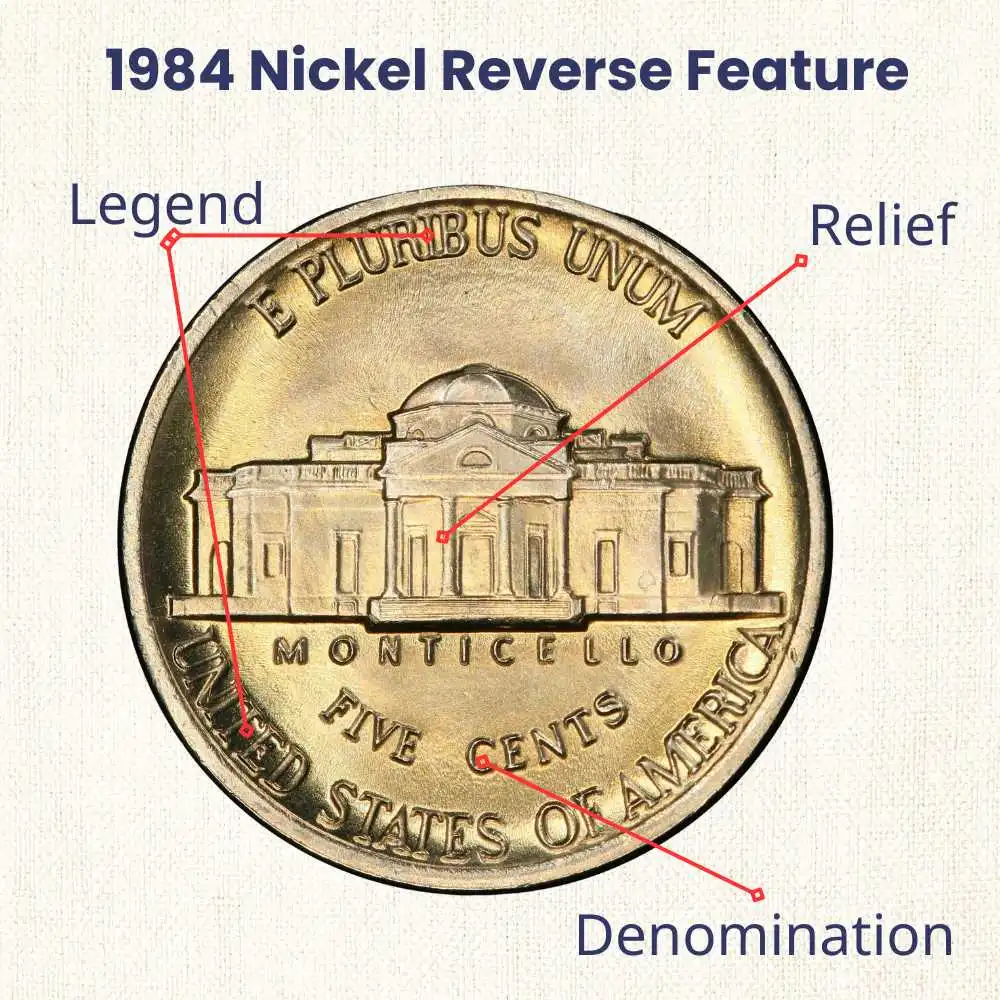
The reverse of the 1984 Nickel was also designed by Felix Schlag. It includes the following characters:
- The motto “E PLURIBUS UNUM”
- The front view of the Monticello mansion
- The word “MONTICELLO”
- The denomination “FIVE CENTS“
- The country of issue “UNITED STATES OF AMERICA“
1984 Nickel: Varieties and Valuation
There are three main varieties of the 1984 Jefferson Nickel, and they include
1984-P Nickel Value

- U.S. Mint: Philadelphia
- Mintage: 746,769,000
- Mint Mark: P
It’s not uncommon for coins to leave the Philadelphia Mint without a mint mark. Not the 1984-P Nickels; those had an actual “P” as the mint mark. They made way over 746 million coins, giving the Philadelphia Mint the title of the highest mintage in 1984.
Some of these coins were well-struck with six steps on Monticello, while others only showed five steps. But a majority of them showed fuzzy steps. I guess quantity doesn’t necessarily translate to quality.
This indifference made examples with full steps rarer and, therefore, more desirable than regular-struck 1984-P Nickels with fuzzy steps. And yes, examples with full steps are more valuable than similarly graded coins with fuzzy steps.
Circulated regular-struck (without full steps) are worth between 10 cents and 15 cents, depending on their condition. 1984-P Nickels with full steps are nearly impossible to find in circulated states. The wear of circulation has a way of filing down the detail on the steps.
In uncirculated condition, examples with full steps are worth $10 to $160, depending on their condition and how many steps they show. Uncirculated regular-struck 1984-P Nickels are worth between $0.25 and $75.
Perhaps the table below will do a better job comparing the value of these sub-varieties of the 1984-P Nickel:
| 1984-P Nickel Condition | Estimated Value | ||
| Regular-Struck 1984-P Nickels | 1984-P Nickels Showing 5 Steps | 1984-P Nickels Showing 6 Steps | |
| Good (G4) | $0.10 | – | – |
| Very Good (VG8) | $0.10 | – | – |
| Fine (F12) | $0.10 | – | – |
| Very Fine (VF20) | $0.10 | – | – |
| Extremely Fine (XF40) | $0.10 | – | – |
| About Uncirculated (AU50) | $0.10 | – | – |
| Uncirculated (MS60) | $0.25 | – | – |
| Brilliant Uncirculated (MS65) | $10 | $20 | $75 |
| Brilliant Uncirculated (MS67) | $75 | $160 | – |
It is important that you understand that the figures above are only estimates published by the Numismatic Guaranty Company (NGC). In an auction, 1984-P Nickels can sell for way above or even less than these quoted figures.
One coin that failed to meet its estimated value is a 1984-P Jefferson Nickel that was auctioned off at GreatCollections. It was graded a brilliant MS64FS with full steps, yet it only sold at a measly $7.
The biggest sales of 1984-P Nickels involve some form of error. The biggest sale ever recorded by PCGS of a 1984-P Nickel was sold at Heritage Auctions for $834. The coin was struck on a dime planchet and was graded MS65. We’ll talk more about this coin in the error coin section.
1984-D Nickel Value
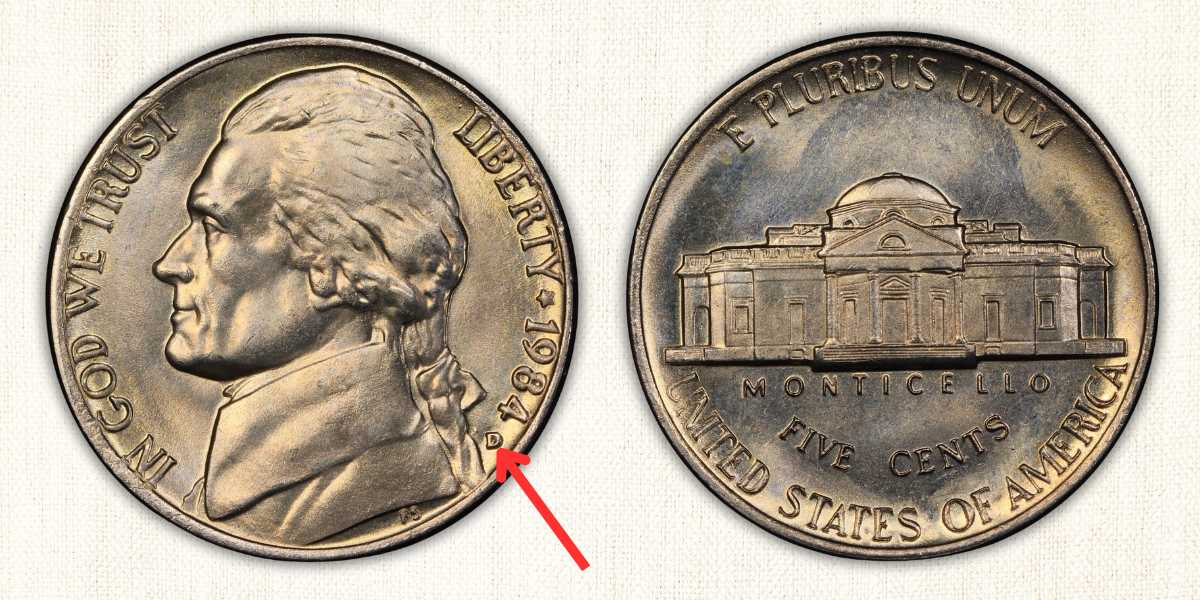
- U.S. Mint: Denver
- Mintage: 517,675,146
- Mint Mark: D
Regarding production quality, the Denver Mint didn’t fare any better in comparison to its Philadelphia counterpart. It also struggled to mint well-struck coins with full steps.
1984-D Jefferson Nickels are about as valuable as similarly-graded 1984-P Nickels. Circulated regular-struck coins are worth between 10 cents and 15 cents. Uncirculated examples can be worth as much as $70 in the right condition.
| 1984 Nickel Condition | Estimated Value | ||
| Regular-Struck 1984-D Nickels | 1984-D Nickels,
5 Steps |
1984-D Nickels,
6 Steps |
|
| Good (G4) | $0.10 | – | – |
| Very Good (VG8) | $0.10 | – | – |
| Fine (F12) | $0.10 | – | – |
| Very Fine (VF20) | $0.10 | – | – |
| Extremely Fine (XF40) | $0.10 | – | – |
| About Uncirculated (AU50) | $0.10 | – | – |
| Uncirculated (MS60) | $0.25 | – | – |
| Uncirculated (MS65) | $7.50 | $30 | – |
| Brilliant Uncirculated (MS66) | $20 | $140 | $500 |
| Brilliant Uncirculated (MS67) | $70 | – | – |
What made the Denver Mint’s production in 1984 so special was it also struck an unknown number of proof-like 1984-D Nickels with full steps. Are you curious about the value of these coins? Perhaps the table below will help:
| 1984-D Nickel Condition | Estimated Value | |
| 1984-D Nickels,
Proof-Like, 5 Steps |
1984-D Nickels,
Proof-Like, 6 Steps |
|
| Uncirculated (MS60) | – | – |
| Uncirculated (MS64) | – | $5 |
| Brilliant Uncirculated (MS65) | $40 | $6 |
| Brilliant Uncirculated (MS66) | $200 | – |
The 1984-D Nickel has also sold some valuable coins including:
| Variety | Coin Grade | Sales Price | Auction Firm |
| Full steps, 5 steps | MS67FS | $1,440 | Heritage Auctions |
| Full Steps | MS66FS | $253 | Heritage Auctions |
| Full Steps | MS66FS | $230 | Heritage Auctions |
| Full Steps | MS66FS | $71 | GreatCollections |
1984-S Proof Nickel Value

- U.S. Mint: San Francisco
- Mintage: 3,065,110
- Mint Mark: S
In 1984, the San Francisco Mint produced only proof versions of the 1984 Jefferson Nickel. These coins were not released into circulation like the 1984-P and 1984-D Nickels. Instead, the 1984-S Nickels were sold to collectors, who took good care of them and maintained their mint state.
1984-S Nickels were well-struck with full steps. However, the minting process used by the San Francisco Mint yielded three proof varieties: Proof, Cameo, and Deep Cameo coins.
Proof coins hold the least value among the 1984-S Nickels, with NGC valuing them between $0.30 and $12.50. Cameo equivalents can fetch between $0.35 and $15, depending on their condition. The Deep Cameos are the most valuable, with NGC estimating their value between $0.05 and $650.
Below is a highlight of the value of these varieties.
| 1984-S Nickel Condition | Estimated Value | ||
| Proof (PF) | Cameo (CAM) | Deep Cameo (DCAM) | |
| Uncirculated (MS60) | $0.30 | $0.35 | $0.50 |
| Uncirculated (MS61) | $0.40 | $0.50 | $0.75 |
| Uncirculated (MS62) | $0.65 | $0.75 | $1 |
| Uncirculated (MS63) | $0.90 | $1 | $1.50 |
| Uncirculated (MS64) | $1.25 | $1.50 | $2 |
| Uncirculated (MS65) | $1.75 | $2 | $2.50 |
| Uncirculated (MS66) | $2.50 | $3.50 | $5 |
| Uncirculated (MS67) | $5 | $6 | $7.50 |
| Uncirculated (MS68) | $7.50 | $8.50 | $12.50 |
| Uncirculated (MS69) | $12.50 | $15 | $25 |
| Uncirculated (MS70) | – | – | $650 |
Despite superior eye appeal, the 1984-S is less valuable than similarly graded 1984-P and 1984-D Nickels. A few factors are working against the 1984-S Nickel in this regard.
First, 1984 is not such a long time ago. Sure, 40 years is something, but not quite enough to render a coin rare. The other thing is there are way too many 1984-S Proof Nickels in mint condition. NGC alone has graded 1,177 of these coins. You can only imagine how many are out there.
As for notable sales, the transaction below made the biggest ripples on the auction block.
| Variety | Coin Grade | Sales Price | Auction Firm |
| Deep Cameo | PR70DCAM | $3,738 | Heritage Auctions |
| Deep Cameo | PR70DCAM | $1,045 | GreatCollections |
| Deep Cameo | PR70DCAM | $978 | Heritage Auctions |
| Deep Cameo | PR70DCAM | $880 | GreatCollections |
1984 Nickel: Valuable Error Coins
From what we’ve gathered so far, the 1984 Nickel is not such a valuable coin. It appears as though you need a perfect coin to score some good money. Perhaps one will have a better chance when they own an error coin.
Below are some valuable error coins in the 1984 Nickel family:
1984-P Nickel Struck on a Dime Planchet: Sold for $834

We start with a coin you’re already familiar with. The same one we mentioned among notable 1984-P Nickel sales. It was struck on a smaller 10-cent planchet. The larger nickel die deformed the coin, flattening it into an imperfect circle.
1984-P Jefferson Nickel Struck on a Dime Planchet: Sold for $431.25
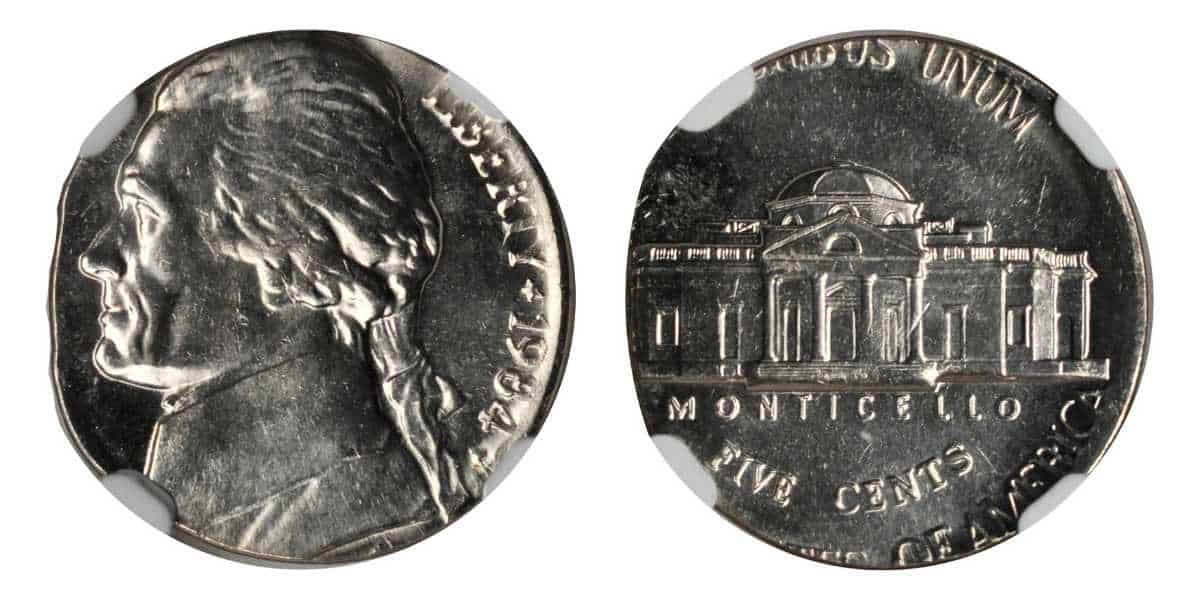
Here’s another coin that was struck on a smaller dime planchet. This nickel is graded MS65 and fails to show full steps. Overall, it is a brilliant example with superior eye appeal.
1984-P Nickel Double Struck with Off-Center Error: Sold for $322
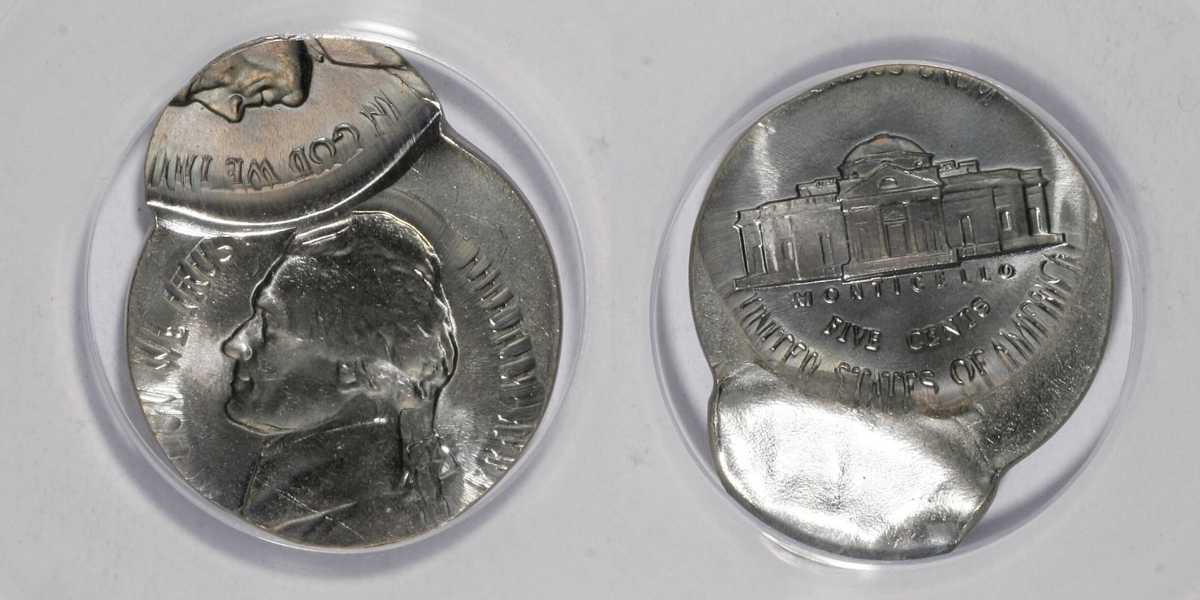
This nickel seems to be splitting into two coins. This effect is the result of two errors. The coin must have veered off its center while it was being struck (maybe due to a faulty collar). The second strike must have struck a new coin from the edge of the original planchet.
1984-P Nickel with Flip-Over and Double Struck Errors: Sold for $66
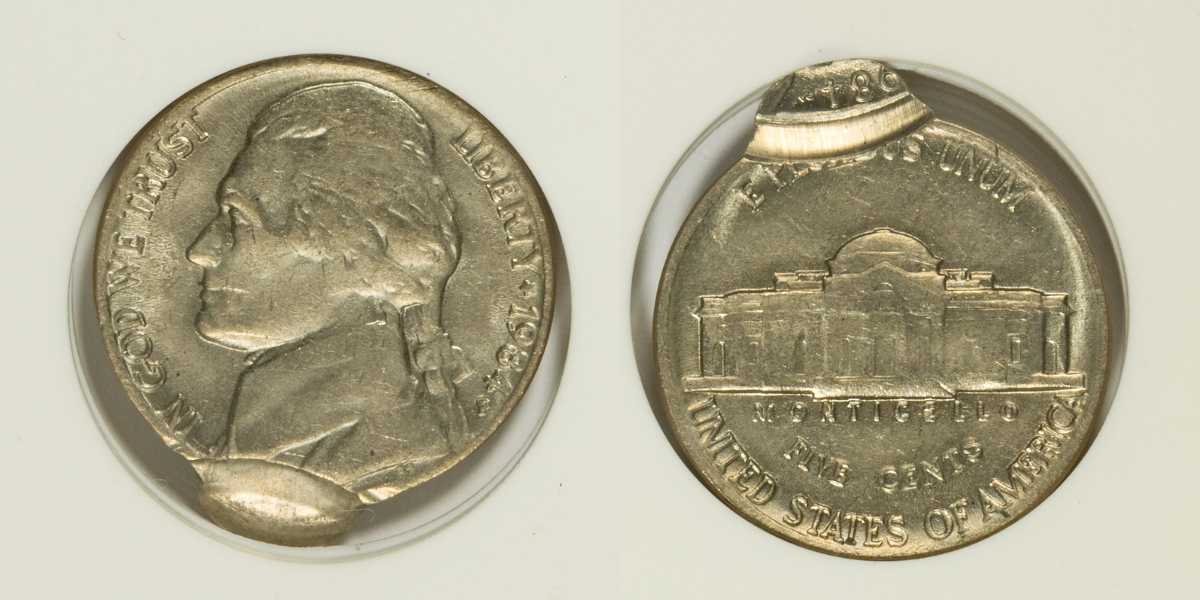
This Jefferson Nickel has a combination of two errors: a flip-over anomaly and a double strike. Thanks to these errors, the coin appears to have a growth on the lower rim. At AU55, it is not in the best condition, but it is an interesting coin to look at.
1984-P Nickel Struck Off-Center: Sold for $21

This example only has a simple off-center error. Thomas Jefferson’s portrait seems to be lifted, with most of the lettering and numbering distorted. This nickel is graded MS62 by IGC.
1984 Nickel: Is it Worth Collecting?
The 1984 Nickel is not such a valuable coin, mainly because they are such a recent release. There are way too many 1984 Nickels in the open market, with many of them being in mint condition. For your coin to score a decent price, it has to have a grade north of MS65 with all six steps showing.
It is still a good coin to add to any collection, but only if you know what you’re getting into.


Jenson is a professional numismatist, a dedicated coin collector, a graduate of the College of Business at Oregon State, a life member of the American Numismatic Association (ANA), and an overall coin nerd. He is the founder of Coin Value List.
